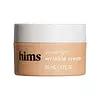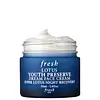What's inside
What's inside
 Key Ingredients
Key Ingredients

 Benefits
Benefits

 Concerns
Concerns

 Ingredients Side-by-side
Ingredients Side-by-side

Water
Skin ConditioningIsopropyl Palmitate
EmollientGlycerin
HumectantCaprylic/Capric Triglyceride
MaskingPropanediol
SolventCetearyl Isononanoate
EmollientButyrospermum Parkii Butter
Skin ConditioningNylon 6/12
AbsorbentOctyldodecanol
EmollientPolyacrylamide
Cetearyl Alcohol
EmollientBeheneth-25
CleansingHydroxyacetophenone
AntioxidantC13-14 Isoparaffin
EmollientParfum
MaskingPEG-100 Stearate
Glyceryl Stearate
EmollientCetearyl Glucoside
EmulsifyingCetyl Palmitate
EmollientLaureth-7
EmulsifyingUrea
BufferingTrehalose
HumectantCaffeine
Skin ConditioningHydrolyzed Trigonella Foenum-Graecum Seed Extract
HumectantXanthan Gum
EmulsifyingCoumarin
PerfumingBenzyl Salicylate
PerfumingPentylene Glycol
Skin ConditioningSerine
MaskingSodium Hyaluronate
HumectantLimonene
PerfumingLinalool
PerfumingPhenoxyethanol
PreservativeCitronellol
PerfumingButylphenyl Methylpropional
PerfumingAlpha-Isomethyl Ionone
PerfumingAdansonia Digitata Pulp Extract
EmollientDisodium Phosphate
BufferingPullulan
Caprylyl Glycol
EmollientAlgin
MaskingWater, Isopropyl Palmitate, Glycerin, Caprylic/Capric Triglyceride, Propanediol, Cetearyl Isononanoate, Butyrospermum Parkii Butter, Nylon 6/12, Octyldodecanol, Polyacrylamide, Cetearyl Alcohol, Beheneth-25, Hydroxyacetophenone, C13-14 Isoparaffin, Parfum, PEG-100 Stearate, Glyceryl Stearate, Cetearyl Glucoside, Cetyl Palmitate, Laureth-7, Urea, Trehalose, Caffeine, Hydrolyzed Trigonella Foenum-Graecum Seed Extract, Xanthan Gum, Coumarin, Benzyl Salicylate, Pentylene Glycol, Serine, Sodium Hyaluronate, Limonene, Linalool, Phenoxyethanol, Citronellol, Butylphenyl Methylpropional, Alpha-Isomethyl Ionone, Adansonia Digitata Pulp Extract, Disodium Phosphate, Pullulan, Caprylyl Glycol, Algin
Water
Skin ConditioningGlycerin
HumectantIsononyl Isononanoate
EmollientGlyceryl Stearate
EmollientCaprylic/Capric Triglyceride
MaskingButylene Glycol
HumectantPentylene Glycol
Skin ConditioningC10-18 Triglycerides
EmollientDiglycerin
HumectantButyrospermum Parkii Butter
Skin ConditioningPEG-100 Stearate
Myristyl Myristate
EmollientNelumbo Nucifera Extract
Skin ConditioningPrunus Persica Leaf Extract
EmollientCitrus Limon Peel Oil
MaskingCucumis Sativus Fruit Extract
EmollientNelumbo Nucifera Flower Extract
Skin ConditioningAnthemis Nobilis Flower Oil
MaskingTocopheryl Acetate
AntioxidantTocopherol
AntioxidantBehenyl Alcohol
EmollientAmmonium Acryloyldimethyltaurate/Beheneth-25 Methacrylate Crosspolymer
Emulsion StabilisingCetearyl Alcohol
EmollientCetyl Palmitate
EmollientCocoglycerides
EmollientAcrylates/C10-30 Alkyl Acrylate Crosspolymer
Emulsion StabilisingParfum
MaskingSodium Hydroxide
BufferingT-Butyl Alcohol
PerfumingSodium Metabisulfite
AntioxidantBHT
AntioxidantTetrasodium EDTA
Ethylhexylglycerin
Skin ConditioningPotassium Sorbate
PreservativeSodium Benzoate
MaskingPhenoxyethanol
PreservativeLimonene
PerfumingBenzyl Salicylate
PerfumingCitral
PerfumingWater, Glycerin, Isononyl Isononanoate, Glyceryl Stearate, Caprylic/Capric Triglyceride, Butylene Glycol, Pentylene Glycol, C10-18 Triglycerides, Diglycerin, Butyrospermum Parkii Butter, PEG-100 Stearate, Myristyl Myristate, Nelumbo Nucifera Extract, Prunus Persica Leaf Extract, Citrus Limon Peel Oil, Cucumis Sativus Fruit Extract, Nelumbo Nucifera Flower Extract, Anthemis Nobilis Flower Oil, Tocopheryl Acetate, Tocopherol, Behenyl Alcohol, Ammonium Acryloyldimethyltaurate/Beheneth-25 Methacrylate Crosspolymer, Cetearyl Alcohol, Cetyl Palmitate, Cocoglycerides, Acrylates/C10-30 Alkyl Acrylate Crosspolymer, Parfum, Sodium Hydroxide, T-Butyl Alcohol, Sodium Metabisulfite, BHT, Tetrasodium EDTA, Ethylhexylglycerin, Potassium Sorbate, Sodium Benzoate, Phenoxyethanol, Limonene, Benzyl Salicylate, Citral
Ingredients Explained
These ingredients are found in both products.
Ingredients higher up in an ingredient list are typically present in a larger amount.
Benzyl Salicylate is a solvent and fragrance additive. It is an ester of benzyl alcohol and salicylic acid. This ingredient can be naturally found in some plants and plant extracts.
In fragrances, Benzyl Salicylate may be a solvent or a fragrance component. In synthetic musk scents, it is used as a solvent. For floral fragrances such as lilac and jasmine, it is used as a fragrance component. The natural scent of Benzyl Salicylate is described as "lightly-sweet, slightly balsamic".
While Benzyl Salicylate has been associated with contact dermatitis and allergies, emerging studies show it may not be caused by this ingredient alone.
However, this ingredient is often used with fragrances and other components that may cause allergies. It is still listed as a known allergen in the EU. We recommend speaking with a professional if you have concerns.
Another study from 2021 shows Benzyl Salicylate may have anti-inflammatory properties.
Learn more about Benzyl SalicylateThis ingredient is also known as shea butter. It is an effective skin hydrator and emollient.
Emollients help soothe and soften your skin. It does this by creating a protective film on your skin. This barrier helps trap moisture and keeps your skin hydrated. Emollients may be effective at treating dry or itchy skin.
Shea butter is rich in antioxidants. Antioxidants help fight free-radicals, or molecules that may harm the body. It is also full of fatty acids including stearic acid and linoleic acid. These acids help replenish the skin and keep skin moisturized.
While Shea Butter has an SPF rating of about 3-4, it is not a sunscreen replacement.
Shea butter may not be fungal acne safe. We recommend speaking with a professional if you have any concerns.
Learn more about Butyrospermum Parkii ButterThis ingredient is an emollient, solvent, and texture enhancer. It is considered a skin-softener by helping the skin prevent moisture loss.
It helps thicken a product's formula and makes it easier to spread by dissolving clumping compounds.
Caprylic Triglyceride is made by combining glycerin with coconut oil, forming a clear liquid.
While there is an assumption Caprylic Triglyceride can clog pores due to it being derived from coconut oil, there is no research supporting this.
Learn more about Caprylic/Capric TriglycerideCetearyl alcohol is a mixture of two fatty alcohols: cetyl alcohol and stearyl alcohol. It is mainly used as an emulsifier. Emulsifiers help prevent the separation of oils and products. Due to its composition, it can also be used to thicken a product or help create foam.
Cetearyl alcohol is an emollient. Emollients help soothe and hydrate the skin by trapping moisture.
Studies show Cetearyl alcohol is non-toxic and non-irritating. The FDA allows products labeled "alcohol-free" to have fatty alcohols.
This ingredient is usually derived from plant oils such as palm, vegetable, or coconut oils. There is debate on whether this ingredient will cause acne.
Due to the fatty acid base, this ingredient may not be Malassezia folliculitis safe.
Learn more about Cetearyl AlcoholCetyl Palmitate is a wax-like substance.
It comes from palmitic acid and palmityl alcohol. Cetyl Palmitate may not be safe for Malassezia folliculitis, or fungal-acne.
This ingredient is naturally found in the guava fruit and stony corals.
Learn more about Cetyl PalmitateGlycerin is already naturally found in your skin. It helps moisturize and protect your skin.
A study from 2016 found glycerin to be more effective as a humectant than AHAs and hyaluronic acid.
As a humectant, it helps the skin stay hydrated by pulling moisture to your skin. The low molecular weight of glycerin allows it to pull moisture into the deeper layers of your skin.
Hydrated skin improves your skin barrier; Your skin barrier helps protect against irritants and bacteria.
Glycerin has also been found to have antimicrobial and antiviral properties. Due to these properties, glycerin is often used in wound and burn treatments.
In cosmetics, glycerin is usually derived from plants such as soybean or palm. However, it can also be sourced from animals, such as tallow or animal fat.
This ingredient is organic, colorless, odorless, and non-toxic.
Glycerin is the name for this ingredient in American English. British English uses Glycerol/Glycerine.
Learn more about GlycerinGlyceryl Stearate is a mix of glycerin and stearic acid.
It is used to stabilize the mixing of water and oil ingredients. By preventing these ingredients from separating, it can help elongate shelf life. It can also help thicken the product's texture.
As an emollient, it helps soften skin and supports barrier-replenishing ingredients.
In cosmetics, Glyceryl Stearate is often made from vegetable oils or synthetically produced.
This ingredient may not be fungal-acne safe
Fun fact: The human body also creates Glyceryl Stearate naturally.
Learn more about Glyceryl StearateLimonene is a fragrance that adds scent and taste to a formulation.
It's found in the peel oil of citrus fruits and other plants such as lavender and eucalyptus. The scent of limonene is generally described as "sweet citrus".
Limonene acts as an antioxidant, meaning it helps neutralize free radicals.
When exposed to air, oxidized limonene may sensitize the skin. Because of this, limonene is often avoided by people with sensitive skin.
The term 'fragrance' is not regulated in many countries. In many cases, it is up to the brand to define this term. For instance, many brands choose to label themselves as "fragrance-free" because they are not using synthetic fragrances. However, their products may still contain ingredients such as essential oils that are considered a fragrance.
Learn more about LimoneneParfum is a catch-all term for an ingredient or more that is used to give a scent to products.
Also called "fragrance", this ingredient can be a blend of hundreds of chemicals or plant oils. This means every product with "fragrance" or "parfum" in the ingredients list is a different mixture.
For instance, Habanolide is a proprietary trade name for a specific aroma chemical. When used as a fragrance ingredient in cosmetics, most aroma chemicals fall under the broad labeling category of “FRAGRANCE” or “PARFUM” according to EU and US regulations.
The term 'parfum' or 'fragrance' is not regulated in many countries. In many cases, it is up to the brand to define this term.
For instance, many brands choose to label themselves as "fragrance-free" because they are not using synthetic fragrances. However, their products may still contain ingredients such as essential oils that are considered a fragrance by INCI standards.
One example is Calendula flower extract. Calendula is an essential oil that still imparts a scent or 'fragrance'.
Depending on the blend, the ingredients in the mixture can cause allergies and sensitivities on the skin. Some ingredients that are known EU allergens include linalool and citronellol.
Parfum can also be used to mask or cover an unpleasant scent.
The bottom line is: not all fragrances/parfum/ingredients are created equally. If you are worried about fragrances, we recommend taking a closer look at an ingredient. And of course, we always recommend speaking with a professional.
Learn more about ParfumPeg-100 Stearate is an emollient and emulsifier. As an emollient, it helps keep skin soft by trapping moisture in. On the other hand, emulsifiers help prevent oil and water from separating in a product.
PEGS are a hydrophilic polyether compound . There are 100 ethylene oxide monomers in Peg-100 Stearate. Peg-100 Stearate is polyethylene glycol ester of stearic acid.
Pentylene glycol is typically used within a product to thicken it. It also adds a smooth, soft, and moisturizing feel to the product. It is naturally found in plants such as sugar beets.
The hydrophilic trait of Pentylene Glycol makes it a humectant. As a humectant, Pentylene Glycol helps draw moisture from the air to your skin. This can help keep your skin hydrated.
This property also makes Pentylene Glycol a great texture enhancer. It can also help thicken or stabilize a product.
Pentylene Glycol also acts as a mild preservative and helps to keep a product microbe-free.
Some people may experience mild eye and skin irritation from Pentylene Glycol. We always recommend speaking with a professional about using this ingredient in your routine.
Pentylene Glycol has a low molecular weight and is part of the 1,2-glycol family.
Learn more about Pentylene GlycolPhenoxyethanol is a preservative that has germicide, antimicrobial, and aromatic properties. Studies show that phenoxyethanol can prevent microbial growth. By itself, it has a scent that is similar to that of a rose.
It's often used in formulations along with Caprylyl Glycol to preserve the shelf life of products.
Water. It's the most common cosmetic ingredient of all. You'll usually see it at the top of ingredient lists, meaning that it makes up the largest part of the product.
So why is it so popular? Water most often acts as a solvent - this means that it helps dissolve other ingredients into the formulation.
You'll also recognize water as that liquid we all need to stay alive. If you see this, drink a glass of water. Stay hydrated!
Learn more about Water